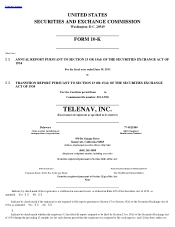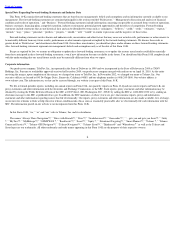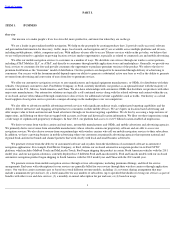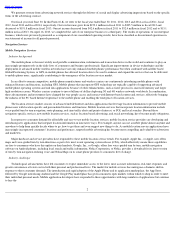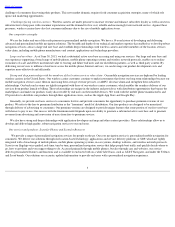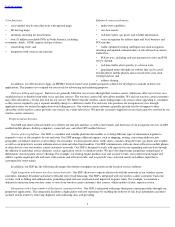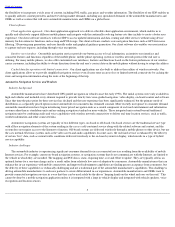TeleNav 2013 Annual Report Download - page 7
Download and view the complete annual report
Please find page 7 of the 2013 TeleNav annual report below. You can navigate through the pages in the report by either clicking on the pages listed below, or by using the keyword search tool below to find specific information within the annual report.
Table of Contents
We generate revenue from advertising network services through the delivery of search and display advertising impressions based on the specific
terms of the advertising contract.
Our fiscal year ends June 30. In this Form 10-K, we refer to the fiscal year ended June 30, 2011, 2012, 2013 and 2014 as fiscal 2011, fiscal
2012, fiscal 2013 and fiscal 2014, respectively. Our total revenue grew from $199.1 million in fiscal 2011 to $205.5 million in fiscal 2012 and
decreased to $191.8 million in fiscal 2013. Our net income decreased from $42.6 million in fiscal 2011 to $32.4 million in fiscal 2012 and to $13.1
million in fiscal 2013. On April 16, 2013, we completed the sale of our enterprise business to a third party. The results of operations of our enterprise
business, which were previously presented as a component of our consolidated operating results, have been classified as discontinued operations in
our statement of income for all periods presented.
Navigation Services
Mobile Navigation Services
Industry background
The mobile phone is the most widely used portable communication, information and transaction device in the world and continues to play an
increasingly prominent role in the daily lives of consumers and business professionals. Significant improvements in device technologies and the
deployment of advanced mobile wireless networks have not only enhanced mobile phones' performance but when combined with satellite based
Global Positioning System, or GPS, in mobile phones has allowed location data to be used to enhance and expand the services that can be delivered
to mobile phone users, significantly contributing to the emergence of the location services market.
In an effort to remain competitive, mobile phone manufacturers and wireless carriers are continuously introducing mobile phones with
enhanced features and functions, including GPS. Mobile phones that incorporate GPS technology are typically capable of supporting advanced
mobile phone operating systems and rich data applications because of other enhancements, such as faster processors, increased memory and larger
high resolution screens. Wireless carriers continue to invest billions of dollars deploying 3G and 4G wireless networks worldwide. In combination,
these advancements and investments have changed the way people access and interact with Internet-based content and services, effectively bringing
the richness of the PC based Internet experience to the mobile phone and enabling the emergence of location services.
The location services market consists of advanced mobile Internet and data applications that leverage location information to provide mobile
phone users with location specific and personalized features and functions. Mobile location services that incorporate location information include
voice-guided turn by turn navigation, route planning, real time traffic alerts and points of interest, or POI, and local searches. Beyond these
navigation-
specific services, new mobile location services, such as location based advertising, and social networking, have become nearly ubiquitous.
In response to consumer demand for affordable and easy-to-use mobile location services, mobile location service providers are developing and
introducing new applications that integrate location information in innovative ways. For example, anyone can use a mobile phone almost anytime and
anywhere to help them quickly decide where to go, how to get there and even suggest new things to do. As mobile location service applications have
increasingly incorporated consumers' locations and preferences, targeted mobile advertising has become more compelling and valuable to advertisers
and marketers.
Major hardware and service providers have responded to these mobile location service trends. For example, Apple Inc., or Apple, now offers
maps and voice-guided turn by turn directions as part of its most recent operating system release (iOS6), which effectively means these capabilities
are free to consumers who have this update on their handsets. Google, Inc., or Google, offers free voice-guided turn by turn, mobile navigation
software on Android phones, including local search and traffic information. Nokia Corporation, or Nokia, provides a download for its latest version
of turn by turn navigation utilizing voice and Nokia Maps on its smart phone products to consumers free of charge.
Industry challenges
Technological advancements have led consumers to expect immediate access to the latest, most accurate information, real-time responses and
greater convenience at lower cost in both their personal and professional lives. The market for mobile services has undergone a dramatic shift in
response to these consumer demands. The introduction and rapid adoption of the Apple iPhone and its application marketplace, the App Store,
followed by Google introducing Android and the Google Play marketplace has given consumers open markets within which to shop in order to meet
their individual personal needs. Mobile application developers have responded to these opportunities with large numbers of applications but continue
to face the
2


